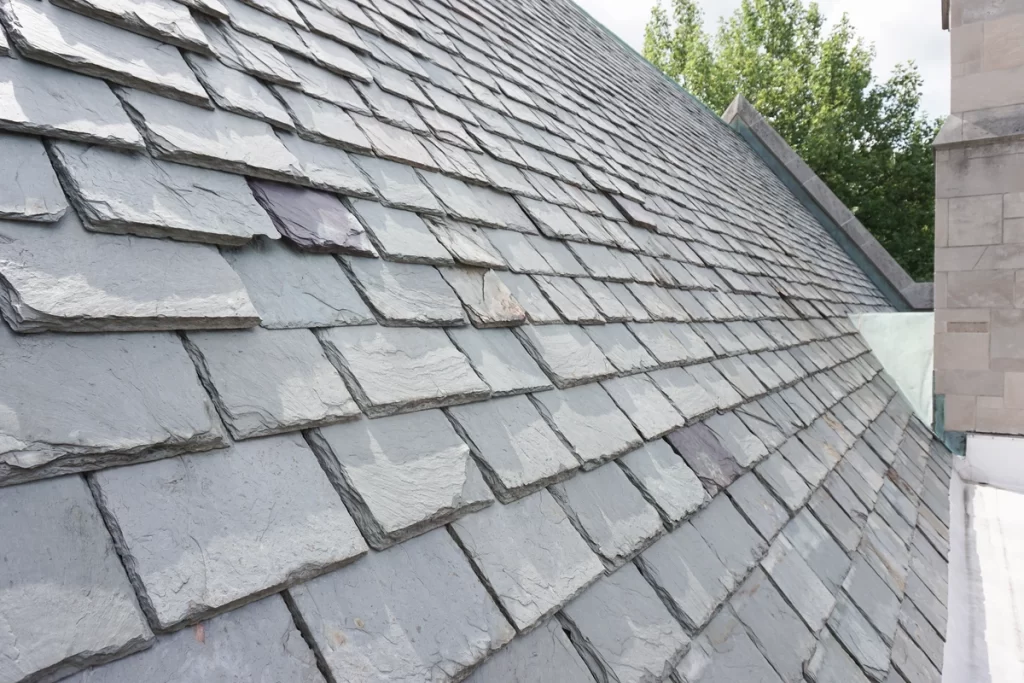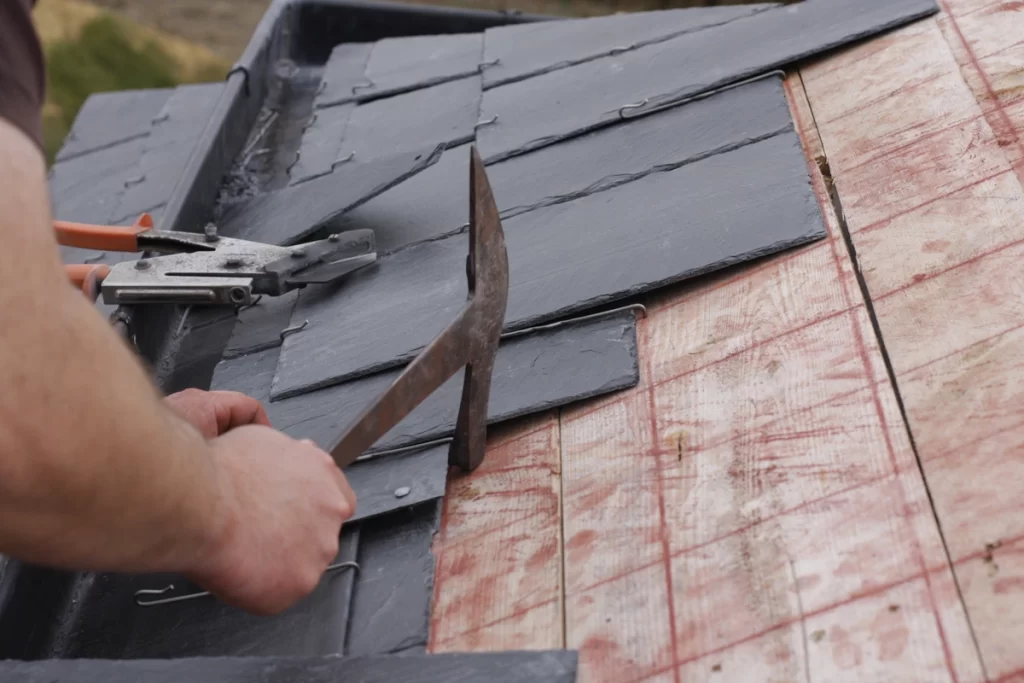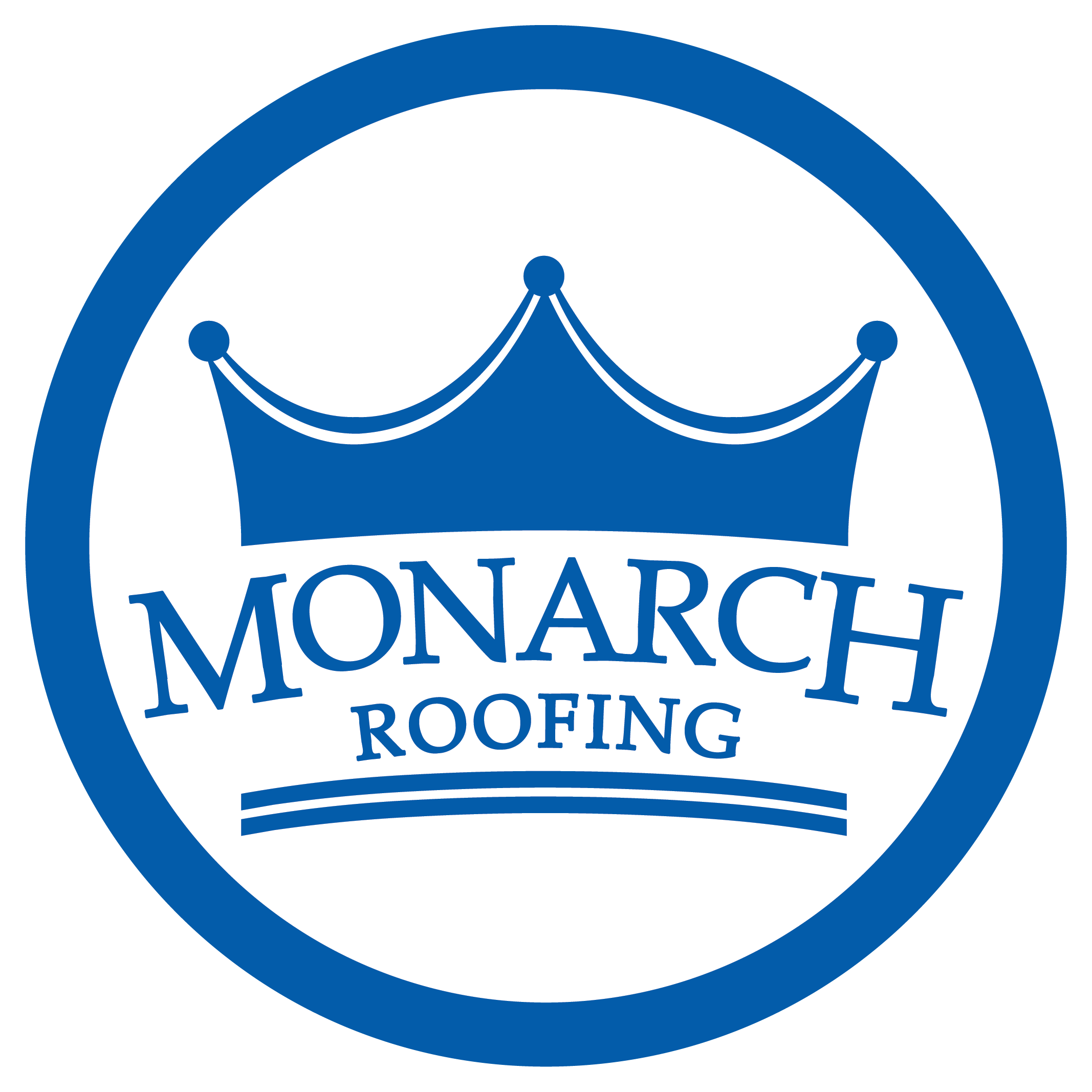When it comes to roofing materials, few can match the timeless appeal and durability of slate. For centuries, slate has been prized for its natural beauty, longevity, and unmatched performance as a roofing material.
This blog is designed to help you delve into everything you need to know about slate roof installation, including:
- What slate roofing is
- Different styles available
- Its pros and cons
- The cost of installation
- Its lifespan
- How to determine if slate is the right choice for your home
What is Slate Roofing?

Slate roofing is crafted from natural stone, typically extracted from quarries. It’s cut into thin, flat pieces that are then installed as overlapping tiles on the roof. This roofing material is renowned for its elegant appearance, with a distinctive texture and color variations that add character to any structure. Slate comes in various shades, ranging from deep charcoal to vibrant green, offering homeowners a wide array of aesthetic options to complement their architectural style.
Different Styles of Slate Roofing
Slate roofing comes in several styles, each with its own unique characteristics and installation methods:
Traditional Slate:
This style features rectangular or square-shaped slate tiles of uniform size, arranged in neat rows across the roof surface. Traditional slate roofing is timeless and suits a wide range of architectural designs, from colonial to contemporary.
Patterned Slate:
Patterned slate roofs introduce creativity and visual interest by incorporating different tile shapes, sizes, and colors. Common patterns include diamond, zigzag, and fish-scale arrangements, allowing homeowners to personalize their roof’s appearance.
Textured Slate:
Textured slate tiles boast a rough, irregular surface that adds rustic charm and dimension to the roof. This style is popular for achieving a weathered, aged look that blends seamlessly with historic or countryside homes.
Graduated Slate:
Graduated slate roofing utilizes tiles of varying lengths and widths to create a staggered, layered effect. This style imparts a sense of depth and dimension to the roof, enhancing its visual appeal and architectural allure.
Pros and Cons of Slate Roofing
Before committing to slate roof installation, it’s essential to weigh the advantages and drawbacks of this premium roofing material:
✅ Pros:
- Durability: Slate is renowned for its exceptional durability and resistance to weathering, fire, and pests. A properly installed slate roof can last a century or more, outlasting many other roofing materials by decades.
- Aesthetic Appeal: Few roofing materials can rival the natural beauty and elegance of slate. Its rich colors, unique textures, and timeless appearance enhance the curb appeal and value of any home.
- Low Maintenance: Slate requires minimal maintenance compared to other roofing materials. It is naturally resistant to mold, mildew, and rot, reducing the need for frequent cleaning or repairs.
- Environmentally Friendly: As a natural stone product, slate is eco-friendly and sustainable. It has a low environmental impact compared to synthetic roofing materials and can be recycled at the end of its lifespan.
❌ Cons:
- High Cost: Slate roofing is among the most expensive roofing materials available, both in terms of material and installation costs. The initial investment can be prohibitive for some homeowners, although the long-term durability and lifespan may justify the expense.
- Weight: Slate is considerably heavier than other roofing materials, which can pose structural challenges during installation. Reinforcements may be necessary to support the added weight, especially for older or weaker roof structures.
- Fragility: While highly durable, slate tiles can be brittle and susceptible to breakage if not handled or installed correctly. Care must be taken during installation and maintenance to prevent damage to the tiles.
- Limited Color Options: While slate offers a range of natural colors, the selection may be more limited compared to synthetic roofing materials that can be custom-colored. Homeowners seeking specific hues may find their options constrained with slate.
8 Steps in the Slate Roof Installation Process
Installing a slate roof requires careful planning, precise craftsmanship, and adherence to industry best practices to ensure a durable, long-lasting result. While the specific steps may vary depending on the project’s scope and complexity, the following outline provides a general overview of the slate roof installation process:
1) Assessment and Preparation:
Before beginning the installation, a thorough assessment of the existing roof structure is conducted to identify any structural issues or deficiencies that need to be addressed. This may include inspecting the roof deck, ensuring proper ventilation, and reinforcing support structures if necessary. Additionally, any old roofing materials are removed, and the roof surface is cleaned and prepared for the installation.
2) Underlayment Installation:
A high-quality underlayment is essential for protecting the roof deck from moisture infiltration and providing a smooth, even surface for the slate tiles. Typically, a layer of roofing felt or synthetic underlayment is applied over the entire roof surface, followed by metal flashing around roof penetrations, such as chimneys, vents, and skylights, to prevent water leaks.
3) Layout and Scribing:
The layout of the slate tiles is carefully planned to ensure optimal coverage and aesthetic appeal. Each tile is individually inspected for size, thickness, and quality, and adjustments are made as needed to accommodate the roof’s pitch and dimensions. Scribing tools may be used to trim tiles to fit around roof features and edges accurately.
4) Installation of Starter and Ridge Courses:
The installation begins with the starter course, which consists of specially cut slate tiles positioned along the eaves to provide a secure base for the rest of the roof. Next, ridge tiles are installed along the peak of the roof to create a watertight seal and enhance the roof’s appearance. These courses are critical for maintaining the structural integrity and weather resistance of the roof.
5) Field Tile Installation:
With the starter and ridge courses in place, the field tiles are installed in overlapping rows from the eaves to the ridge. Each slate tile is carefully positioned and secured with copper or stainless steel nails to prevent uplift and ensure a tight fit. Proper nail placement is essential to avoid damaging the tiles and maintain the roof’s integrity.
6) Flashing Installation:
Flashing is installed in key areas of the roof, such as valleys, hips, and dormers, to redirect water away from vulnerable areas and prevent leaks. Lead or copper flashing is custom-formed and meticulously installed to create a seamless barrier against water intrusion. Proper flashing is essential for protecting the roof from water damage and prolonging its lifespan.
7) Finishing Touches and Cleanup:
Once all the slate tiles and flashing are installed, any remaining trim work, such as installing ridge caps and hip tiles, is completed to provide a polished, professional appearance. The job site is thoroughly cleaned, and any debris or waste materials are removed to ensure a tidy finish and safe working environment.
8) Inspection and Quality Assurance:
A final inspection is conducted to verify that the installation meets industry standards and manufacturer specifications. Any deficiencies or issues are addressed promptly to ensure the roof’s performance and longevity. Quality assurance measures, such as water testing and thermal imaging, may be employed to identify potential leaks or weak points and address them before they become significant problems.
Cost of Slate Roof Installation

The cost of slate roof installation can vary significantly depending on several factors, including the size and complexity of the roof, the quality of the slate tiles, labor costs, and geographic location. On average, homeowners can expect to pay between $600 to $1,500 per square (100 square feet) for materials and installation. However, premium-grade slate and intricate designs can drive up the cost considerably.
While the upfront cost of slate roofing may be higher than other options, it’s essential to consider the long-term value and lifespan of the investment. With proper maintenance, a slate roof can provide a century or more of reliable performance, making it a cost-effective choice over time.
Lifespan of Slate Roofing
One of the most compelling benefits of slate roofing is its exceptional lifespan. When installed correctly and maintained properly, a slate roof can endure for 100 years or more, surpassing the lifespan of most other roofing materials. This longevity not only reduces the need for frequent replacements but also minimizes the environmental impact associated with roof maintenance and disposal.
The durability of slate is attributed to its natural composition, which is resistant to moisture, UV exposure, and thermal fluctuations. Unlike asphalt shingles or wooden shakes, which deteriorate over time, slate retains its structural integrity and aesthetic appeal for generations, making it a wise investment for homeowners seeking lasting quality and performance.
Choosing Slate Roofing: Is It Right for You?
Deciding whether slate roofing is the right choice for your home requires careful consideration of several factors, including budget, architectural style, climate, and personal preferences. Here are some key points to keep in mind when evaluating slate as a roofing option:
- Budget: Slate roofing represents a significant upfront investment, so it’s essential to assess your budget and determine whether the long-term benefits outweigh the initial cost. While the price may be higher compared to other materials, the durability and lifespan of slate can provide excellent value over time.
- Architectural Style: Slate roofing complements a wide range of architectural styles, from historic to contemporary. Consider how the color, texture, and pattern of slate tiles will enhance the overall aesthetic of your home and blend seamlessly with its design.
- Climate: Slate is well-suited to various climates, thanks to its resistance to moisture, heat, and freeze-thaw cycles. However, it’s essential to consider local weather conditions and consult with a roofing professional to ensure proper installation techniques and maintenance practices are followed.
- Maintenance: While slate requires minimal maintenance compared to other roofing materials, periodic inspections and repairs may be necessary to address any issues that arise. Factor in the time and cost associated with maintenance when evaluating the suitability of slate for your home.
- Long-Term Plans: If you plan to remain in your home for many years or pass it down to future generations, slate roofing offers unmatched longevity and durability. However, if you anticipate selling your home in the near future, consider whether the investment in slate will provide a significant return on investment or enhance its market appeal.
Make The Switch to Slate With Monarch!
Slate roof installation offers homeowners a timeless combination of beauty, durability, and longevity that few other roofing materials can match. While the initial cost may be higher compared to alternatives, the exceptional lifespan and low maintenance requirements make slate roofing a wise investment for those seeking lasting quality and performance.
Contact the roofing professionals at Monarch Roofing to learn if a slate roof is right for your home!





